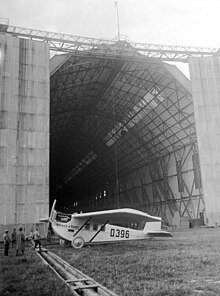Dornier Comet I and II
| Dornier Comet I / II | |
|---|---|

|
|
| Type: | Airliner |
| Design country: | |
| Manufacturer: | |
| First flight: |
February 10, 1921 (Comet I) |
| Commissioning: |
May 3, 1923 |
| Number of pieces: |
Comet I: 6, Comet II: 11 |
The Dornier Do C III comet I and P Thu Comet II were single-engine high-wing aircraft - Commercial aircraft of the Constance -based aircraft manufacturer Dornier works from the 1920s. The first flight of Comet I took place on February 10, 1921, and Komet II flew for the first time on October 9, 1922.
history
The models Komet I and Komet II were land versions of the commercial flying boat Delphin . The wings and tail units largely matched, only the fuselage could be modified, as it no longer had to serve as a boat. It was also very low, so that entry was possible without any aids. In the cabin, the passengers sat opposite each other in pairs, the pilot's seat was open on the fuselage behind the wing.
The differences between Komet I and Komet II were mainly in the engines used and the associated differences in terms of dimensions, power and mass. As early as the New Year's Eve 1922, flew Comet II as Germany's first commercial airliner to London Lympne, after a planned transport connection was on May 3, 1923 London - Berlin opened. Soon afterwards the route Moscow - Odessa was flown and from March 1924 also the route Berlin - Dresden - Prague - Vienna . In addition to Germany, the Dornier Komet also flew in the USSR , Spain and Colombia .
construction
The Dornier Komet was a high-wing aircraft with braced, non-braced all-metal wings. The fuselage was made of all-metal half-shell construction and was very close to the ground. The tail unit was also made of all-metal in normal construction, the rudders were aerodynamically balanced. The axis of the landing gear was partly in the fuselage and outside it was clad like a wing; a simple spur was attached to the stern.
The power unit for the Komet I was the liquid-cooled upright six-cylinder in-line engine BMW IIIa with 185 hp, for the Komet II a Rolls-Royce Falcon III with 260 hp. Both models had a fixed two-bladed wooden propeller.
Technical specifications
| Parameter | Dates (Do C Comet I ) | Dates (Do P Comet II ) |
|---|---|---|
| crew | 1-2 | |
| Passengers | 4-6 | |
| length | 10.20 m | 10.28 m |
| span | 17.00 m | |
| height | 2.75 m | |
| Wing area | 50.00 m² | 47.40 m² |
| Empty mass | 1250 kg | 1500 kg |
| Payload | 750 kg | |
| Takeoff mass | 2000 kg | 2250 kg |
| drive | BMW IIIa with 185 PS (136 kW) | Rolls-Royce Falcon III with 260 PS (191 kW) |
| Two-bladed propeller | ||
| Fuel supply | 305 l | 322 l |
| Top speed | 165 km / h near the ground 142 km / h at 2000 m altitude |
170 km / h near the ground |
| Cruising speed | 130 km / h near the ground | 135 km / h near the ground |
| Service ceiling | 4800 m | 4500 m |
| Rise time | 10 min at 1000 m altitude 25 min at 2000 m altitude |
k. A. |
| Range | 680 km | 720 km |
| Flight duration | 4 h | |
| Take-off run | 190 m | k. A. |
| Landing runway | 140 m | k. A. |
literature
- Heinz AF Schmidt: Historic aircraft. Transpress Verlag, Berlin, VLN 162-925 / 25/68.
- Günter Frost, Karl Kössler , Volker Koos: Dornier - From the beginnings to 1945. HEEL Verlag, 2010, ISBN 978-3-86852-049-1 .
Web links
Individual evidence
- ↑ a b c d Frost, Kössler, Koos: Dornier. P. 42.
- ↑ http://www.3d-historisch.de/Dornier/Delphin.htm
- ↑ http://www.histaviation.com/Dornier_Komet_I.html


